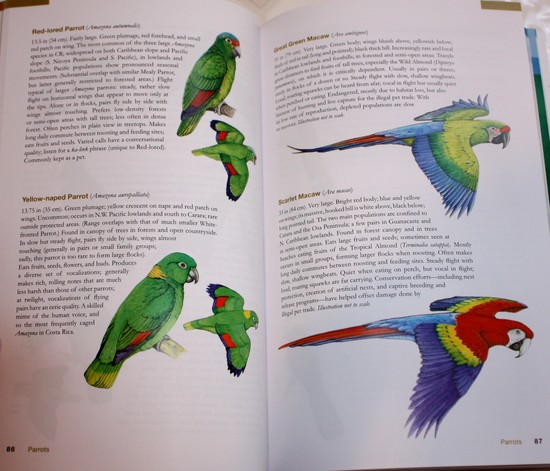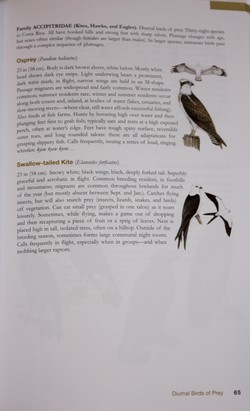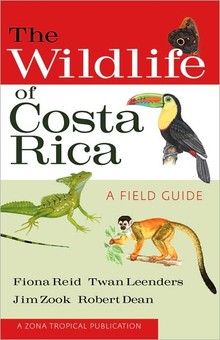Reviewed by Grant McCreary on August 7th, 2010.
Costa Rica. To a birder like me, those words conjure visions of an avian paradise: cloud forests bejeweled by Resplendent Quetzals, Scarlet Macaws flying over the rain forest, and hummingbirds flitting around flowers. However, Costa Rica is home to more than just birds (gasp!). There are butterflies, poison dart frogs, iguanas, lizards that run across water, sloths, and monkeys, just to name a few. In fact, though I was primarily looking for birds, many of my most memorable sightings in Costa Rica involve animals other than birds.
The Wildlife of Costa Rica is a field guide to many of the mammals, birds, reptiles, amphibians, and arthropods you may see there. Seeing as Costa Rica boasts over 800 species of birds and God-only-knows how many arthropods, by necessity this is more of a sampler than comprehensive guide. Most of the species were selected because they are easy to see, while others were chosen for their beauty or distinctiveness.
For the species that are included, you get a relatively extensive text account and one or more painted illustrations. The bird images have been taken from the excellent field guide by Richard Garrigues and Robert Dean (also from Cornell University Press). Oddly, it does not seem that the mammal have likewise been taken from their Mammals of Costa Rica
field guide. For the most part, all look good and are very consistent. Some of the mammals and snakes look a little awkward to me, but they’re the exception.
Text accounts cover description, status, distribution, habitat, habits, diet, and vocalizations. It’s a nice mix of information needed for identification and other interesting tidbits. Disappointingly, no range maps are included, even though at the very least maps for birds and mammals could have been taken from their respective individual field guides.

Interspersed throughout the book are 24 sidebars, or “natural history vignettes”. Some focus on single species, such as Brown-throated Three-toed Sloths, while others describe general phenomena like frog calls. These make for fascinating reading and are good supplements. There is also a short general introduction, covering the country’s geography, habitats, and weather. Taxonomic groups each have their own intro, from a full page for the classes (mammals, birds, etc) to single paragraphs for orders and families.
My main issue with this guide is its use of space – an amazing amount of it is wasted, especially in the bird section. Some pages have so much white space left at the bottom that an additional species (or two!) could have been included. At the very least, there should have been room for some range maps.

Unfortunate design leaves too much white space, while keeping some illustrations too small.
Some may find issue with the species selection or the amount of coverage that each group receives. Granted, I’ve only been to Costa Rica once, but I think they did a commendable job. Most of the birds and other animals I saw are included here. Roughly, half of the guide is devoted to birds, but that’s about right given their popularity and conspicuousness.
Comparison to Other Guides
Costa Rica is a popular destination for ecotravelers and others interested in wildlife, so it’s no surprise that this is not the first guide of its kind. Here are two other popular choices and, in brief, how they compare to this guide.
The Travellers’ Wildlife Guides Costa Rica, by Les Beletsky, also uses paintings to illustrate the same groups of animals, minus arthropods. It includes fewer species from even the groups it does cover, though, and much less species-specific text. There are, however, relatively extensive family-level accounts.
Carrol L. Henderson’s Field Guide to the Wildlife of Costa Rica covers the same groups as the Cornell book, but includes by far the fewest species of the three guides. It uses photographs instead of paintings, and has extensive, and often quite interesting, text accounts. It’s the largest and heaviest of the three, making the title a bit of a stretch.
Henderson has also broken down this large guide into three separate ones: Butterflies, Moths, and Other Invertebrates; Birds
; and Mammals, Amphibians, and Reptiles of Costa Rica
. These are intriguing because they offer greater flexibility than trying to include everything in a single volume. They are more comprehensive than the catch-all guides, but still not nearly enough so to use as primary field guides.
Recommendation
The Wildlife of Costa Rica is a good overview of the country’s diverse wildlife. Of the general guides, I think this one will work best due to its smaller size, yet greater number of species included. It should come in handy for any visitor who’s even slightly interested in the animals they will see there. I know it will for me when I go back.
Disclosure: I get a small commission for purchases made through links in this post.
Disclosure: The item reviewed here was a complementary review copy provided by the publisher. But the opinion expressed here is my own, it has not been influenced in any way.





Very nicely done Grant. I didn’t get a look at this one myself so your review is appreciated even more than usual. Looks like a tome I shall need to add to my shoping list.
We just returned from Costa Rica (Feb., 2012). I am using the book to identify creatures in the photos I took. There is great coverage of the birds. Only 4 pages are devoted to butterflies, making the book all but useless for their identification.